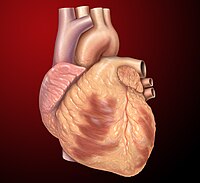
Photo from wikipedia
BACKGROUND Prognostic significance of temporal change in myocardial tissue characterization by cardiovascular magnetic resonance (CMR) has not been elucidated in patients with non-ischemic dilated cardiomyopathy (DCM). METHODS AND RESULTS Sixty-eight… Click to show full abstract
BACKGROUND Prognostic significance of temporal change in myocardial tissue characterization by cardiovascular magnetic resonance (CMR) has not been elucidated in patients with non-ischemic dilated cardiomyopathy (DCM). METHODS AND RESULTS Sixty-eight patients with newly-diagnosed DCM who underwent CMR including late gadolinium enhancement (LGE) both at baseline and during follow-up period were enrolled. LGE score was defined by a signal intensity of ≥5 standard deviations above the remote reference myocardium mean. Left ventricular reverse remodeling (LVRR) defined as a LV ejection fraction increase of ≥10% and a decrease in indexed LV end-diastolic diameter of ≥10% compared to those at baseline was detected in 38% of the patients. There was no significant difference in LGE score between baseline and follow-up (5.8% vs. 7.3%; p=0.38). The change in LGE area (delta-LGE) was significantly lower in patients with LVRR than those without (-0.5%±3.4% vs. 3.0±7.4%; p=0.02). On the other hand, T2 ratio during the follow-up significantly reduced (1.95±0.48 vs. 1.67±0.56; p<0.01); however, there was no significant difference in the change in T2 ratio between patients with LVRR and those without (-0.29±0.73 vs. -0.27±0.66; p=0.88). Multivariate logistic analysis indicated that baseline LGE score [odds ratio; 0.78; 95% confidence interval (CI) 0.66 to 0.90; p<0.01] together with delta-LGE (odds ratio; 0.77; 95% CI 0.61 to 0.92; p=0.01) were independently associated with subsequent LVRR (p<0.01). CONCLUSIONS The temporal change of LGE-CMR score during the clinical course was significantly correlated with following LVRR.
Journal Title: Journal of cardiology
Year Published: 2017
Link to full text (if available)
Share on Social Media: Sign Up to like & get
recommendations!